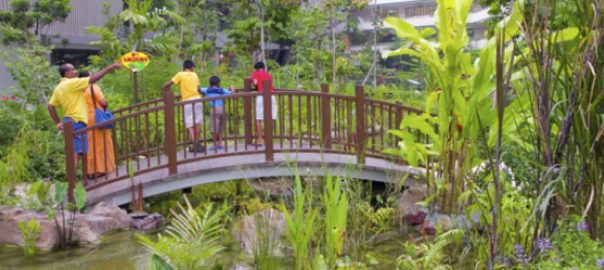Three books inspire me greatly. They are (a) ‘Biophilia’ by E.O. Wilson, (b) ‘Sustaining Life: How Human Health Depends on Biodiversity’ by Eric Chivian and Aaron Bernstein, and (c) ‘Biophilic Cities’ by Tim Beatley.
Written almost thirty years ago, the first postulated that it is imprinted in our DNA that people need connection with biodiversity. Five years ago, the second documented comprehensively the multiple ways in which biodiversity has contributed to our well-being. With more than half the world’s population living in cities, the third book emphasized the importance of integrating nature into urban design and planning.
How can one translate the lessons learnt from these three books to an individual level?
Tim Beatley posted ‘Exploring the Nature Pyramid’ in his TNOC blog on 7 August 2012 where he shared a tool that Tanya Denckla-Cobb initiated and Tim developed to help us conceptualise how much biodiversity we need. Tim posed several thought-provoking questions that triggered some lively discussions.
There is ample evidence of the importance of biodiversity to our health. The key contentions are not whether biodiversity is crucial for human health but rather: (1) how much of what biodiversity do we need for what aspects of our health; and (2) in what form of biodiversity do these requirements have to come?
While there are logical follow-up questions—such as “Are there such things as minimum daily requirements of nature?” or, “What constitutes a ‘serving’ of nature?”, etc.—I would like to work from the premise that it is essential to maximise our daily exposure to and interaction with as much biodiversity in as many forms possible for our physical, mental and spiritual well-being. Moreover, the ground-breaking work carried out by Terry Hartig et al., as published in ‘Tracking restoration in natural and urban field settings’, highlighted that, “for urban populations in particular, easy pedestrian and visual access to natural settings can produce preventive benefits”.
I would like to invite you to join me in the following thought experiment. Let’s walk through a day in our life, consciously ensuring that we maintain a biodiversity view at most, if not all times of day.
Home views
What a refreshing way to start a day when we open our eyes to a green feast every morning through a bedroom window view like this.


On the other hand, it might be so pleasant that we would like to spend the rest of the day in bed, gazing out of the window and indulge in some day-dreaming.
As we drag ourselves out of bed to get a cup of tea or coffee, a verdant spread for the eyes stimulates the mind, better preparing us for a productive day ahead.
Personal actions:
Have you planted any trees or shrubs outside your residence to ensure your daily dose of biodiversity? Do you have pots of flowers to brighten your window ledges? Have you suggested to your apartment’s management committee to plant more trees and shrubs around your apartment block? Are you a member of your neighbourhood’s Community in Bloom group?
Journey views
Tree and shrub-lined roads liven our daily journeys with continuous luscious greenery, keep us cooler, surprise us with fluttering bats, bees and butterflies, clean the air and provide many ecosystem services for free.
Personal actions:
If you had a choice, would you select a route with better scenery along the way?
Having tree-lined streetscape involves commitment by several agencies, including the city councils, planners, road departments, etc. Have you suggested to your city council to plant more native plants that will attract small mammals, bats, bees, birds, butterflies, dragonflies, etc.?

Work views
On an average, we spend around 9 hours per day at the office and at least 6 hours in school. Most offices have windows, preferably with biodiversity views. How does it enrich our lives and improve our health? A bird or butterfly or squirrel can provide interesting entertainment outside the window at different times of the day. They take your attention away from the computer screen, letting your eye muscles relax. Bird songs and the cacophony of cicadas add an element of naturalness to the sounds of technology that currently dominate our lives.
Personal actions:
Have you persuaded the maintenance managers of your office to plant more trees outside the building and to improve the horticultural landscaping? Have they diversified the floral species to include plants that attract birds, butterflies, dragonflies, etc.?
School views
School grounds that have a substantial area of natural ecosystems enjoy many benefits. The students are not only healthier because of the cooler classroom conditions and cleaner air quality but they can also concentrate better. The natural habitats function as living labs within the school grounds, adding a sense of reality to their lessons.
Personal actions:
Have you tried convincing your school to create an eco-garden or dragonfly pond or butterfly patch? Have you carried out a biodiversity audit in your school? Have you tried to increase the biodiversity in your school by planting native species targeted at specific taxonomic groups?

Hospital views
Roger S. Ulrich in his paper in Science, ‘View through a Window May Influence Recovery from Surgery’, concluded: “the results imply that hospital design and siting decisions should take into account the quality of patient window views”.
Mr Liak Teng Lit, Group Chief Executive Officer of the Alexander Health System took this further and ensured that Khoo Teck Puat Hospital (KTPH) is both ‘hospital in a garden’ and ‘a garden in a hospital’. Hence, all the hospital rooms in KTPH have windows with a biodiversity view. KTPH embraces an environmental philosophy that is based on sustainable development and the preservation of biodiversity. Some of the ways that operationalised the environmental policy include: (1) natural ecosystems have been created within the grounds of KTPH; (2) bird and butterfly attracting plants are key landscape features; (3) ponds with native freshwater fish provide one of the water features; (4) a roof top garden, that is lovingly maintained by volunteers and KTPH staff, produces organic vegetables, fruits, herbs and spices; and (5) a lake that harbours native freshwater organisms and provides food for raptors.

Restaurant views
The favourite pastime of Singaporeans is eating. While having breakfast, Singaporeans would most likely be discussing where to have lunch. Since people, especially those living in Singapore, spend at least 20% of their waking hours having meals, it would add on to their dining experience if they can also enjoy a visual biodiversity feast.

If each of us plays our part in trying to make our living spaces populated with biodiversity, there will be more biophilic people living in biophilic cities.
Signing off from a room with a biodiversity-filled window view.
Lena Chan
Singapore








Leave a Reply